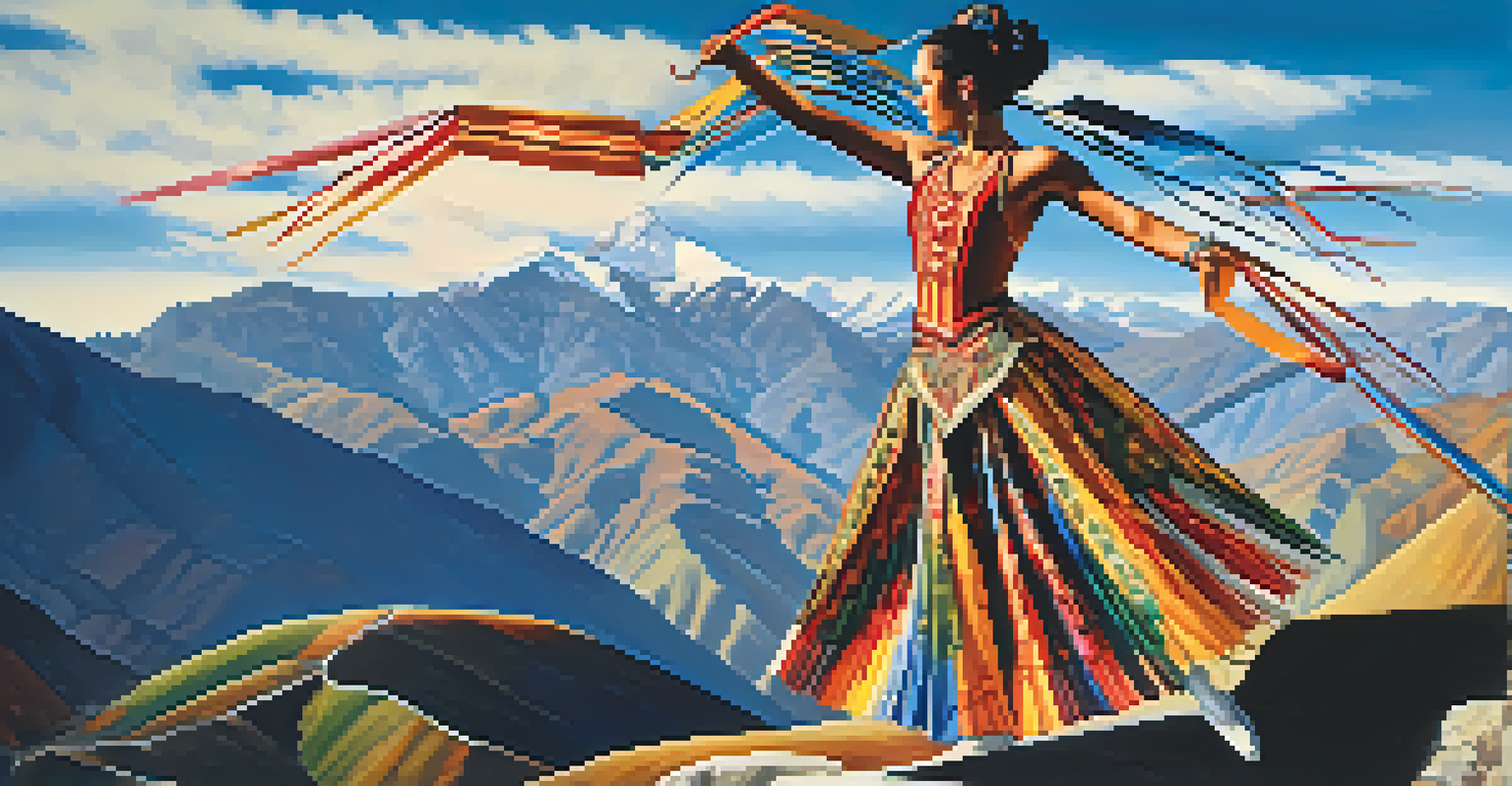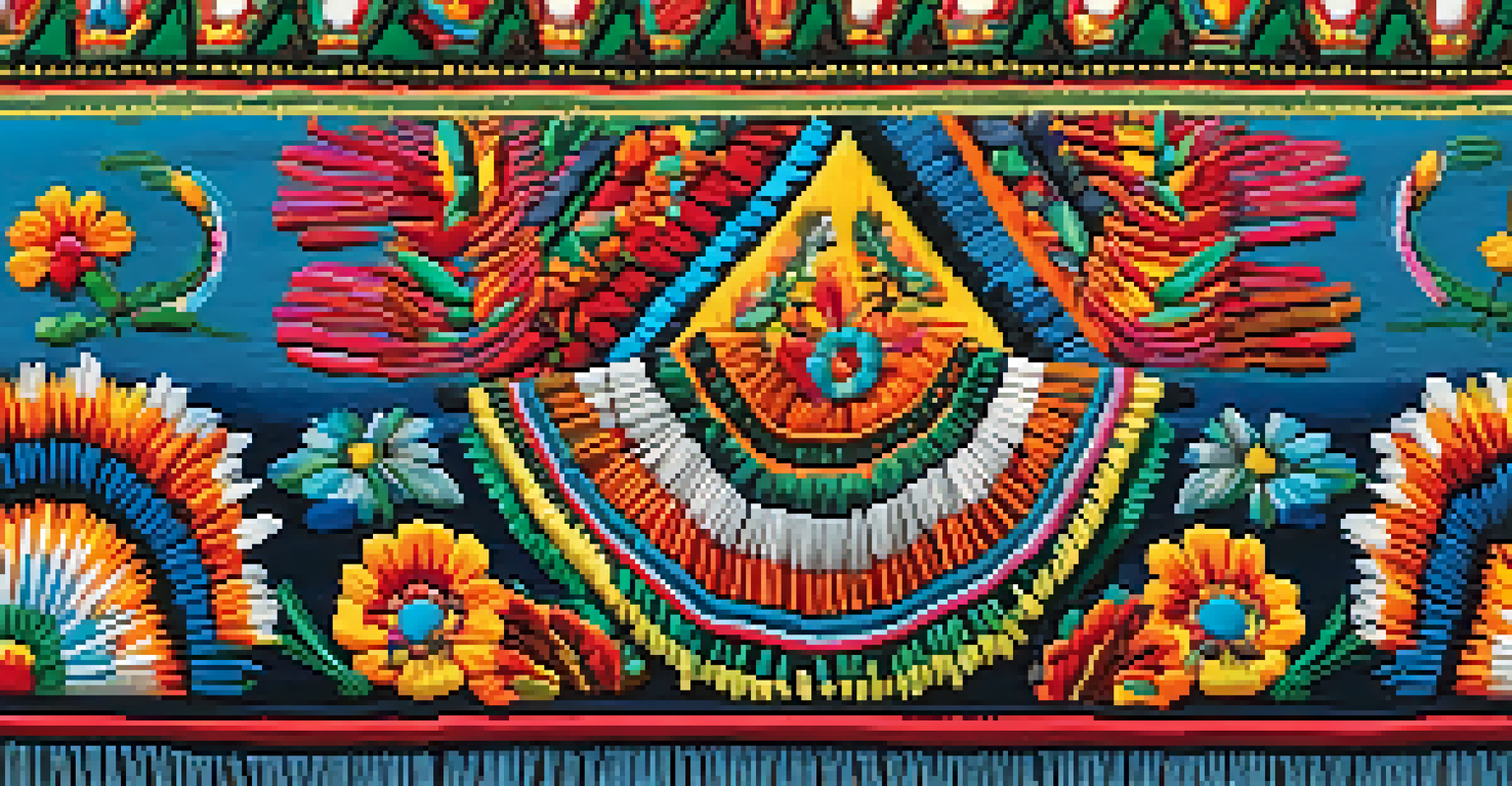Understanding the Symbols in Peruvian Folkloric Dance

The Cultural Significance of Folkloric Dance in Peru
Peruvian folkloric dance is more than just an art form; it is a vibrant expression of the country's rich cultural heritage. Each dance tells a story, often rooted in ancient traditions and beliefs that have been passed down through generations. This connection to history makes folkloric dance a crucial part of Peru's identity, showcasing the diverse influences from Indigenous, Spanish, and African cultures.
Dance is the hidden language of the soul.
For instance, the 'Marinera' dance, often considered the national dance of Peru, symbolizes courtship and love. Its movements reflect the flirtation between a man and a woman, embodying the essence of romance that is deeply ingrained in Peruvian culture. This interplay of cultural elements highlights how dance serves as a medium for storytelling, connecting people to their past and each other.
Moreover, the communal aspect of these dances fosters a sense of belonging and pride among participants. Festivals and celebrations featuring folkloric dance encourage community participation, allowing individuals to express their cultural identity and share it with others, thereby keeping traditions alive.
Common Symbols Found in Peruvian Folkloric Dance
In Peruvian folkloric dance, various symbols convey deeper meanings and cultural narratives. For example, colors often play a significant role, with each hue representing different emotions, regions, or even social status. Bright colors like red and yellow may symbolize joy and celebration, while darker shades can reflect struggle or sorrow.

Costumes are also rich in symbolism, with intricate designs that often depict local flora, fauna, or historical events. The use of traditional textiles, often handcrafted, serves to honor the craftsmanship of Indigenous communities and their connection to the land. Each element of the costume tells a story, making the dance a visual narrative.
Folkloric Dance Reflects Peru's Heritage
Peruvian folkloric dance serves as a vibrant expression of the country's rich cultural heritage, telling stories rooted in ancient traditions and diverse cultural influences.
Additionally, the movements themselves are symbolic. Specific gestures may represent daily activities, such as farming or fishing, while others depict elements of nature, like wind and water. Through these movements, dancers communicate their relationship with the environment, emphasizing the importance of nature in Peruvian life.
The Role of Music in Folkloric Dance Symbolism
Music is an essential component of Peruvian folkloric dance, deeply intertwined with its symbolism. Each dance is accompanied by traditional instruments, such as the guitar, cajón, or pan flute, which not only provide rhythm but also evoke specific emotions associated with the dance. The melodies often reflect the cultural nuances of different regions, adding layers to the storytelling.
Cultural heritage is our legacy from the past, what we live with today, and what we pass on to future generations.
For instance, the lively beats of the 'Huaylas' dance mirror the joyous spirit of Andean festivities, while the slower, more somber tunes of 'Saya' may express themes of struggle and resilience. This relationship between music and dance enhances the overall experience, allowing performers and audiences alike to connect emotionally with the narrative being presented.
Moreover, the interaction between dancers and musicians during performances creates a dynamic atmosphere that emphasizes spontaneity and cultural expression. This synergy not only showcases the talent of both dancers and musicians but also reinforces the communal aspect of Peruvian folkloric dance, making it a shared experience that resonates with everyone involved.
Regional Variations in Dance Symbols Across Peru
Peru's diverse geography and cultures have led to a rich variety of folkloric dances, each with its unique symbols and meanings. For example, dances from the coastal regions often reflect maritime life, incorporating symbols related to the ocean and fishing. In contrast, Andean dances might focus on themes of agriculture and the mountains, showcasing the connection between the people and their landscape.
The 'Festejo' dance from the coast celebrates African heritage and often includes lively, rhythmic movements that symbolize joy and celebration. On the other hand, the 'Q'ochapampa' dance from the highlands features slower, more deliberate movements that reflect the spiritual connection to the Andean mountains. These differences highlight how geography influences cultural expressions through dance.
Symbols Convey Deep Cultural Narratives
In folkloric dance, various symbols, including colors, costumes, and movements, convey deeper meanings that connect dancers to their history and environment.
Furthermore, local festivals and traditions greatly impact the symbolism in dance, often incorporating elements specific to the community's history and beliefs. This regional diversity allows for a rich tapestry of stories to be told through dance, each contributing to the overall narrative of Peru's cultural heritage.
The Influence of Religion on Folkloric Dance Symbols
Religion plays a significant role in shaping the symbols found in Peruvian folkloric dance. Many dances incorporate elements of Catholicism, often blending Indigenous beliefs with Spanish influences. For instance, the 'Danza de las Tijeras' (Dance of the Scissors) is a unique dance that combines religious devotion with acrobatic skill, symbolizing the struggle between good and evil.
The use of religious imagery in dance costumes and movements often reflects the syncretism of beliefs in Peru. Dancers may wear symbols of saints or perform movements that honor deities, merging the spiritual with the artistic. This blending creates a deeper meaning behind the dance, as performers pay homage to their faith while celebrating their cultural identity.
Additionally, religious festivals provide opportunities for communities to come together and express their spirituality through dance. These events often feature elaborate performances that draw on traditional stories of saints and local legends, further enriching the cultural tapestry of Peru. In this way, folkloric dance becomes a powerful medium for expressing faith and community solidarity.
The Evolution of Folkloric Dance Symbols Over Time
Like all art forms, folkloric dance in Peru has evolved over time, adapting to changing cultural landscapes while retaining core symbols and meanings. Historical events, such as colonization and migration, have influenced the way dances are performed and understood, often leading to the incorporation of new elements. This evolution showcases the resilience of cultural identity amidst external influences.
For example, contemporary interpretations of traditional dances may include modern music or innovative choreography, appealing to a broader audience while still honoring the original symbolism. This blend of old and new allows younger generations to connect with their heritage in a way that feels relevant and engaging.
Music Enhances Dance's Emotional Impact
The integration of traditional music with dance creates a dynamic experience that deepens emotional connections and reinforces the communal spirit of Peruvian culture.
Moreover, the global interest in traditional Peruvian dance has prompted a revival of interest in preserving and promoting these cultural expressions. Dance schools and community initiatives are working to maintain the integrity of folkloric dance, ensuring that the symbols and stories behind them continue to be celebrated and passed down through generations.
Conclusion: Celebrating the Symbols of Peruvian Folkloric Dance
Understanding the symbols in Peruvian folkloric dance allows us to appreciate not only the art form itself but also the rich cultural heritage it represents. Each dance is a tapestry of history, emotion, and community, woven together through movement, music, and symbolism. By exploring these elements, we gain insight into the stories and traditions that shape Peruvian identity.
As we celebrate these dances, it’s essential to recognize the importance of preserving their significance for future generations. Engaging with folkloric dance can foster a deeper appreciation for cultural diversity and the narratives that connect us all. Whether through participation or observation, everyone can contribute to keeping these traditions alive.

Ultimately, Peruvian folkloric dance serves as a reminder of the power of art to transcend boundaries and bring people together. By understanding and honoring the symbols embedded in these performances, we celebrate not just the dances themselves but the vibrant cultures and stories that continue to thrive in Peru today.